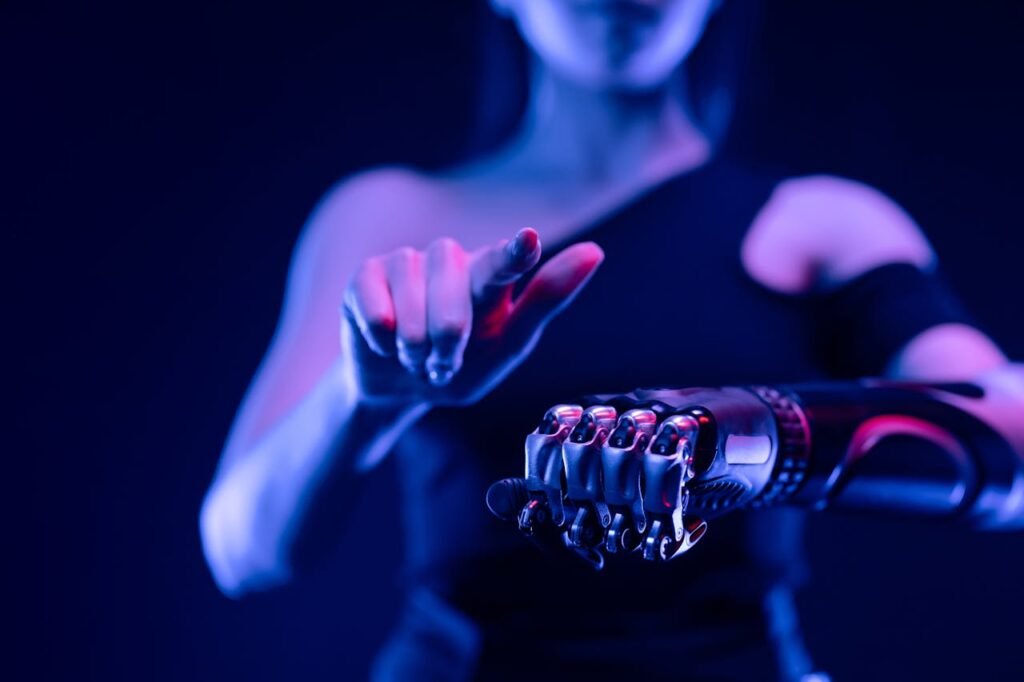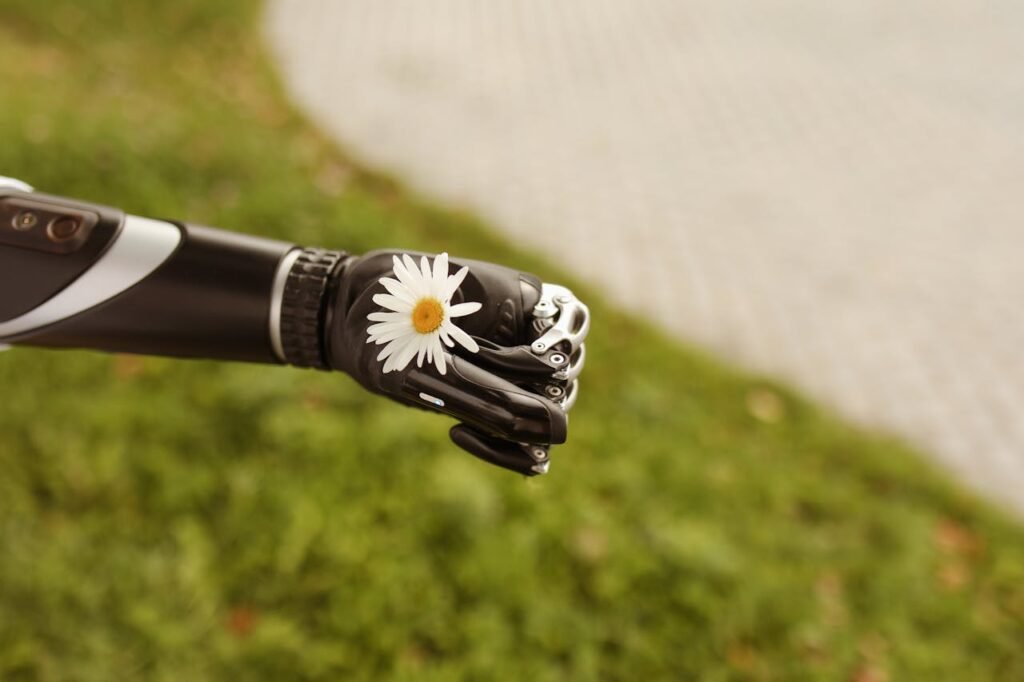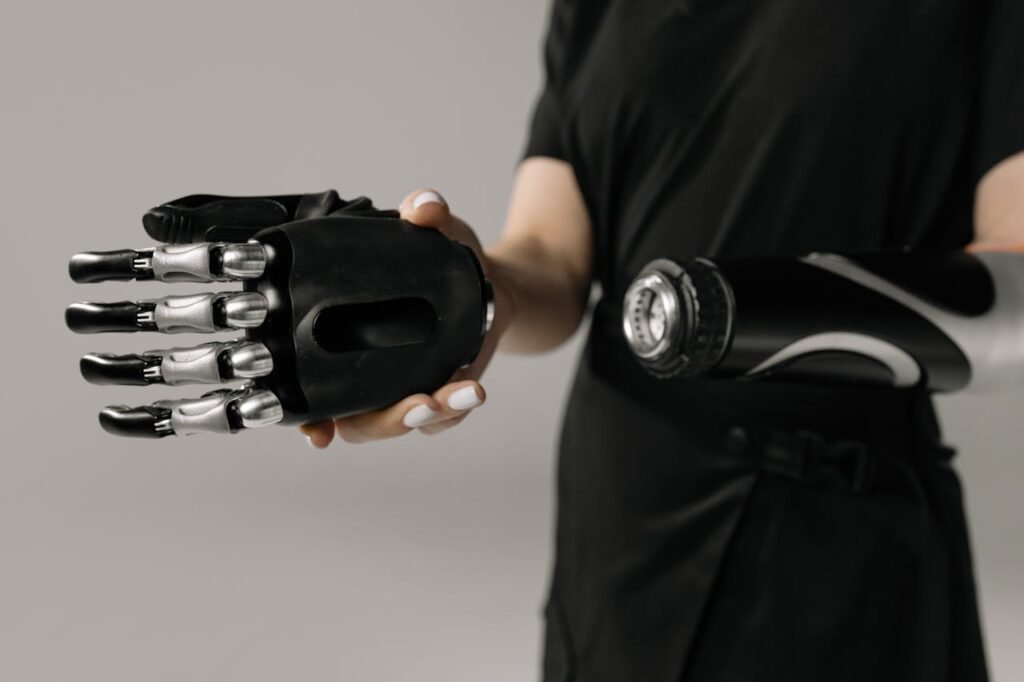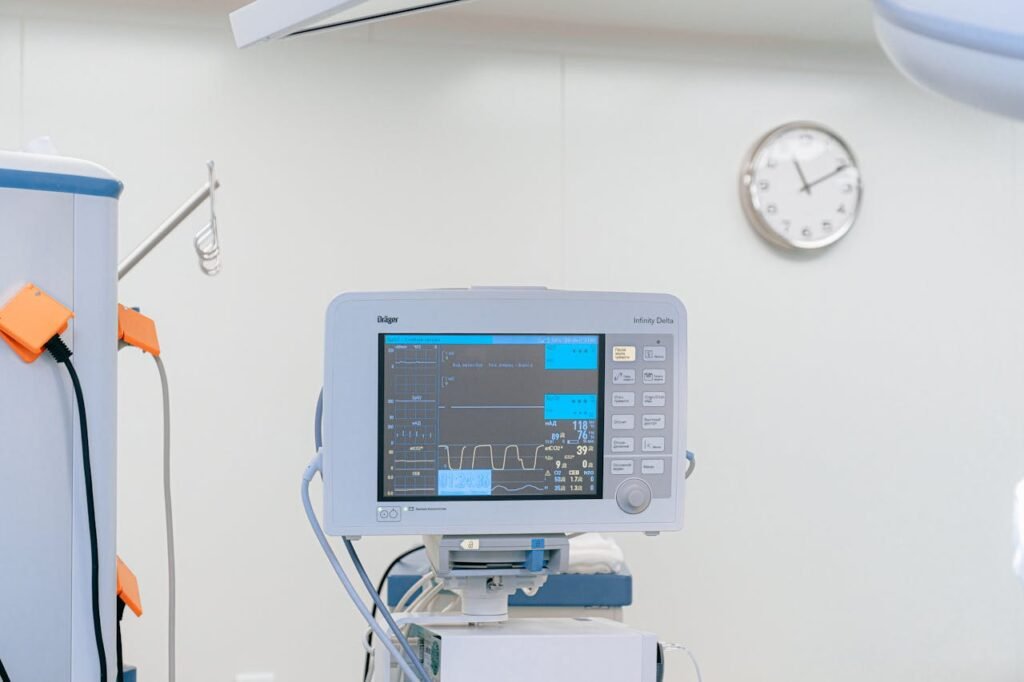Modern bionic limbs are no longer just machines. They are smart, intuitive, and deeply connected to the human body.
But to make them move in a natural and responsive way, they need to understand what the body is trying to say. This starts with reading the right signals.
Those signals can come from the brain, the muscles, or the body’s movement. That’s where EMG, EEG, and IMU come in.
Each of these systems listens to the body differently. EMG reads muscle activity. EEG captures brain signals. IMU tracks movement and orientation.
So, which one is best for adaptive bionics?
At Robobionics, we’ve explored all three. We’ve tested, built, and refined systems that rely on these signals. And in this article, we’ll break down how each one works, where they shine, and what to consider when choosing the right approach.
Because when it comes to helping someone move again, the right signal makes all the difference.
Understanding EMG: Muscle Signals That Power Movement
What is EMG?

EMG stands for Electromyography. It is a way to read the electrical activity produced by muscles.
Every time you try to move your hand, your brain sends signals to your muscles. These signals create tiny electrical pulses. EMG sensors can detect these pulses through the skin and use them to control a bionic hand.
At Robobionics, this is the core of how our Grippy™ Bionic Hand works. It reads signals from the remaining muscles in the user’s forearm and translates them into hand movements.
Why EMG Feels Natural
EMG is popular in prosthetics because it feels very close to how a real hand works. You think about moving your fingers, and the device responds. There’s no extra device to wear on your head. No delay. Just movement that feels direct.
The control becomes intuitive over time. Users don’t need to learn a new language or stare at a screen. They just think in terms of movement—open, close, grip—and the hand listens.
This makes EMG a favorite for people looking to regain quick, responsive hand function.
Strengths of EMG in Adaptive Bionics
EMG offers fast, real-time control. It’s well suited for daily tasks like holding objects, picking up small items, or using tools.
It also supports a range of motions if enough muscle groups are available. For people with below-elbow amputations, this can be a powerful option because several useful muscles are still intact.
Additionally, EMG systems are generally more affordable and easier to integrate into wearable devices. At Robobionics, we focus on making this technology both effective and accessible for users across India.
Challenges with EMG
But EMG is not perfect.
It relies heavily on the quality and consistency of muscle signals. If the user is tired or sweaty, signals may weaken. If the sensors move out of place, accuracy can drop.
This can make the learning curve slightly steep in the beginning. Users need some time to get used to finding just the right muscle contractions.
Also, people with high-level amputations—where fewer muscle groups remain—may not have enough signal sources for precise control.
These limitations push us to explore other signal types, like EEG and IMU.
Exploring EEG: Reading Signals Directly from the Brain
What is EEG?
EEG stands for Electroencephalography. It measures the electrical activity of the brain using sensors placed on the scalp.
Instead of reading muscle movement, EEG tries to read the intention directly from the source—the brain.
The idea is simple and powerful. You think about moving your hand, and the EEG picks up those thoughts and converts them into action.
In practice, though, it’s more complex.
The signals are small. The brain is busy with many thoughts. And sorting through all that noise to find one clear command takes effort, advanced algorithms, and training.
Why EEG Captures the Imagination
EEG is exciting because it opens up control even when muscles can’t be used. For people with very high-level amputations, or those with spinal injuries, EEG offers a way forward.
It’s also non-invasive. The sensors sit on top of the head. No surgery. No implants.
This makes it a useful tool for research, rehabilitation, and early-stage trials in neural control.
It also opens up possibilities for future devices where users could control their limbs just by thinking—no muscle needed.
Strengths of EEG in Bionics
EEG is promising for advanced control systems, especially when paired with AI or machine learning. It allows for a wide range of commands if the signal quality is high enough.
It’s also useful in understanding what the user intends, even before any movement happens. That opens doors for systems that are proactive, not just reactive.
In labs and controlled settings, EEG can show impressive results. It’s a field full of potential.
Where EEG Struggles
However, EEG faces several practical challenges.
First, the signal is weak and noisy. The brain is always active, and it’s hard to isolate the parts related only to hand movement.
Second, the setup is delicate. The sensors need clean skin, gel contact, and minimal movement to stay accurate. This is difficult in real-world, everyday use.
Third, EEG requires training. The user must learn to focus their thoughts a certain way. It can take weeks or months to become skilled.
Lastly, the hardware is still bulky and expensive for many users. At Robobionics, we believe EEG will become more practical in the future—but today, for most people, it’s still not the most user-friendly option.
Understanding IMU: Tracking Motion and Position
What is IMU?

IMU stands for Inertial Measurement Unit. It’s a small device that uses sensors like accelerometers and gyroscopes to track motion, orientation, and acceleration.
IMUs don’t listen to your brain or muscles. Instead, they observe how your limb—or the remaining part of your limb—moves in space.
This data can then be used to control a bionic device. For example, if you tilt your arm forward, the hand might close. If you rotate it, the hand might turn.
The Power of Movement-Based Control
IMUs are useful because they rely on physical motion, not electrical signals. This makes them a strong option when muscle signals are weak or inconsistent.
They’re also helpful for tracking fine movements. A small change in the angle of the wrist or forearm can trigger a command. This makes the control experience more fluid and responsive, especially when paired with myoelectric inputs.
IMUs are already used in many industries—phones, drones, gaming, and more. In prosthetics, they bring that same accuracy into the body.
Where IMU Works Best
IMU is often used in combination with EMG. The EMG controls the hand’s basic movement, while the IMU adds another layer—like wrist rotation or hand positioning.
This layered control can make the experience much more natural. It also reduces the load on any single system, allowing for smoother performance.
At Robobionics, we use IMUs in advanced configurations to expand motion without increasing complexity. When done right, it makes the prosthetic feel like an extension of the user’s intent.
IMUs are also quite durable and require less daily maintenance compared to surface sensors. They don’t rely on skin contact, which reduces signal drift caused by sweat or electrode misplacement.
Challenges of IMU Systems
IMUs don’t work well on their own for detailed hand control. They only detect movement—they don’t tell you what the person wants to do.
That means they often need to be paired with another system to understand intention. Without context, a tilt could mean anything.
They can also be sensitive to sudden jolts or external vibration, which may cause accidental movement or false triggers.
Another concern is calibration. IMUs need to know what “neutral” looks like, and that may change depending on how the prosthetic is worn.
Still, in a hybrid setup, IMUs offer valuable input for creating more adaptive, real-world-friendly bionic systems.
Strategic Insights for Clinics, Innovators, and Tech Startups
Understanding Neural Inputs from a Business Lens

Neural inputs like EMG, EEG, and IMU are not just scientific concepts—they’re commercial decisions. For clinics, prosthetic manufacturers, rehab centers, and healthcare startups, the choice of signal input has long-term implications for patient outcomes, satisfaction, operational efficiency, and cost structure.
Each system brings with it its own value proposition. Understanding these not only helps businesses deliver better care but also supports smarter product development, better training protocols, and stronger partnerships with users and caregivers.
At Robobionics, our work has shown that the most successful solutions aren’t always the most advanced—they’re the most appropriate for the user, the environment, and the budget.
Here’s how you can apply this thinking to your business.
Aligning Technology with Real-World Use
Before selecting or promoting a specific input system, businesses must ask: Where and how will this be used?
For example, a prosthetic device used by a farmer in a rural area of Maharashtra has different needs than a prosthetic used by a software engineer in Bengaluru.
The farmer might need rugged, sweat-resistant EMG sensors that work through dust and heat. The software engineer might be open to trying hybrid systems that offer precision and support finer tasks.
If you offer EEG in such environments without reliable power backup or long-term training support, it may result in early abandonment or poor user experience.
Action Tip: Create user profiles or personas. Match your neural input technology to their lifestyle, environment, and ability to maintain the device. Avoid over-engineering for users who need reliability more than novelty.
Training and Support is Part of the Product
No matter how advanced your input system is, if users and clinicians don’t understand how to use it, it will fail.
EMG systems require basic muscle isolation training. EEG demands focus exercises and long calibration sessions. IMUs may need recalibration and posture control.
Many companies focus on hardware but overlook training infrastructure. This results in poor outcomes, frustrated users, and reduced referrals.
Action Tip: Build a training module for each neural input system you support. This could be as simple as an app-based tutorial, or as comprehensive as in-clinic workshops with physios. Offer these tools not just to users but to clinicians too.
Training boosts retention. And retention boosts long-term business growth.
Think Hybrid, Sell Smarter
One of the most effective ways to create value for your users—and set your products apart—is by exploring hybrid systems.
Hybrid approaches like EMG + IMU or EMG + EEG aren’t just buzzwords. They solve real-world problems by offering layered control.
For instance, you can assign simple open/close gestures to EMG, while using IMU for wrist orientation. Or you can use EEG to trigger high-level commands like “switch grip mode,” leaving precision movement to EMG.
This makes the system more intuitive and responsive without overwhelming the user with commands.
Action Tip: Don’t offer a “one-size-fits-all” solution. Segment your product lines or configurations. Have a basic EMG version, an advanced hybrid model, and a high-tech EEG prototype for research. This way, you serve different budgets and expectations while staying scalable.
Build Your Brand Around Reliability, Not Just Innovation
In bionics, flashy doesn’t always mean functional. Users are looking for devices they can trust—not just in labs, but in kitchens, workplaces, temples, and buses.
For input systems, this means prioritizing signal stability, ease of maintenance, and consistent calibration.
A well-tuned EMG system with robust training will outperform an unstable EEG setup in nearly every real-life scenario.
Action Tip: Invest in case studies that show long-term success with your chosen system. Avoid making promises based only on prototypes. Instead, show reliability over months, not minutes.
This builds trust with clinicians, funders, and users alike.
Educate, Don’t Just Market
Most people, including rehab professionals, don’t fully understand the difference between EMG, EEG, and IMU systems.
That’s your opportunity.
The companies that win in this space won’t just sell—they’ll teach. They’ll empower clinicians with clear explainers. They’ll train rehab teams to use the tech correctly. They’ll create awareness that builds confidence.
Action Tip: Develop simple explainers—short videos, infographics, webinars—that explain how your input systems work. Don’t talk like a neuroscientist. Speak like a guide.
When people understand how something works, they’re more likely to believe in it, use it, and recommend it.
Focus on the Post-Sale Experience
The signal input system is just the beginning. Once a device is sold, users enter a long journey of learning, adapting, and personalizing.
That journey needs support.
Offer follow-ups, remote calibration help, and feedback tracking. This not only ensures success but gives you rich data to improve your future products.
Action Tip: If your product uses EMG, offer a virtual or in-person “check-in” one month after fitting. For EEG systems, build a support protocol for recalibration and retraining. For IMU devices, offer guidance on how to avoid motion errors.
Support turns users into advocates.
Preparing for Growth in a Smart Bionics Market
India’s prosthetic market is growing fast—but unevenly. Urban centers may demand high-tech solutions, while smaller towns may prioritize durability and affordability.
The smart bionics companies of tomorrow will bridge this gap by offering modular, adaptable systems that evolve with the user.
They won’t just sell products. They’ll build ecosystems of care, training, and community support—layered with the right neural input systems for every stage.
At Robobionics, that’s our mission.
EMG vs EEG vs IMU: Comparing Real-World Use
Speed of Response
When it comes to speed, EMG generally wins.
It picks up muscle signals almost instantly and converts them to movement in milliseconds. Users often feel in control very quickly, which builds trust and comfort.
EEG, on the other hand, can have a delay. The brain signals must be processed and filtered, which takes time. For real-time movement, this can feel slow or unreliable.
IMU is also fast, though it depends on movement. It can’t start an action until motion occurs, so it’s best as a supporting input, not a primary trigger.
Ease of Use and Training
EMG systems are relatively easy to learn, especially for people with some remaining muscle control. With short sessions, users can become comfortable and begin daily use quickly.
EEG systems demand more training. The user must learn how to focus their thoughts and stay consistent with mental commands. This takes longer and can feel tiring.
IMU systems are simple in terms of setup but may require regular recalibration. They’re generally intuitive when used for secondary control, like turning the wrist or changing grip modes.
Cost and Accessibility
EMG leads in affordability and availability. It’s widely used, well-researched, and has a mature ecosystem for support and maintenance.
EEG systems are expensive. They often require specialized gear and professional setup, which limits access—especially in countries like India where affordability is key.
IMU systems fall in between. The sensors themselves are affordable and robust, but integrating them into prosthetic workflows still requires technical skill and customization.
Strategic Insights for Clinics, Developers, and Users
Choosing the Right Input System

When selecting a neural input system for bionics, there is no single answer. The best solution depends on many factors—such as the user’s physical condition, their goals, their environment, and the level of daily usage expected.
If the user has good residual muscle activity, EMG is usually the most practical and cost-effective option. It provides fast control, integrates well into most prosthetic limbs, and offers a good balance between responsiveness and ease of training.
For users with very high-level amputations, or for those with limited muscle signals, EEG might be the only available path. But this comes with caveats—higher cost, longer training, and more complexity.
IMU, on its own, may not be enough. But when combined with EMG or EEG, it adds a rich layer of motion data that enhances the overall control experience.
In our work at Robobionics, we’ve found that hybrid models often give the best results. They reduce the load on any single system and allow for smoother, more adaptive behavior—especially in complex, real-world environments.
Use-Case Based Recommendations
If you’re working with users who need a prosthetic for basic daily tasks like eating, grooming, or writing, EMG-based systems are usually ideal. They’re fast, easy to maintain, and give users confidence with minimal setup.
For users involved in advanced use-cases—like artistic work, mechanical tasks, or even sports—a combination of EMG and IMU offers enhanced precision and more nuanced control.
In research labs or rehab centers exploring the limits of mind-controlled interfaces, EEG makes sense. It’s also valuable in therapy for users who can no longer move muscles but still retain cognitive intention.
The goal should always be the same: to match the system with the user’s reality—not just their dream.
Key Questions to Ask When Deciding
Before choosing a neural input system, here are some important questions to consider:
- How much muscle control does the user have?
- Will the prosthetic be used daily or occasionally?
- What kind of training and rehab resources are available?
- How important is affordability in the long term?
- Does the user need precise, multi-layered control—or just simple, functional movement?
These answers guide which system—or combination of systems—is likely to offer the best outcome.
At Robobionics, we guide every user through this decision. We offer demos, assessments, and trials to make sure the final solution isn’t just functional, but empowering.
Looking Forward: The Future of Neural Inputs in Bionics
The Rise of Smarter Systems
In the future, input systems will not just read signals. They’ll learn from them.
Using machine learning, AI, and real-time adaptation, future prosthetics will become even more intuitive. They’ll adjust to muscle fatigue, predict movements, and offer feedback before the user even realizes they need it.
This will reduce the cognitive load. It will make control feel as natural as breathing.
We’re already exploring these ideas in our labs. Our aim is to bring smarter bionic limbs to market—ones that understand the user just as much as the user understands them.
India’s Role in the Global Bionics Revolution
India is often seen as a market for imported medical tech. But that narrative is changing.
With startups like Robobionics leading the way, we are building world-class prosthetics here at home—designed for the Indian body, the Indian climate, and the Indian wallet.
We don’t believe affordability should mean compromise. Our Grippy™ Bionic Hand is proof that innovation, quality, and accessibility can coexist.
As neural input technology grows, we’ll continue to explore how EMG, EEG, and IMU can be adapted, simplified, and scaled—so that more people, in more places, can access the future.
Conclusion: Making the Right Connection
The question of EMG vs EEG vs IMU is not about which is best in theory. It’s about what works best for you—or your patient, or your practice.
Each system has strengths. Each has trade-offs. But all of them, when used with care and purpose, can create life-changing results.
At Robobionics, we believe the right input system is one that feels personal. It responds to your mind, your muscles, your motion—however you can best express yourself.
Because in the end, adaptive bionics isn’t about machines. It’s about people. And the best technology is the one that brings you back to your life, on your terms.
If you’d like to explore which system is right for you, book a free demo today:
Let’s build the connection that works best—for your body, your brain, and your journey.



